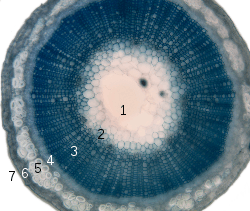Cortex (botany)

1. Pith
2. Protoxylem
3. Xylem I
4. Phloem I
5. Sclerenchyma (bast fibre)
6. Cortex
7. Epidermis
A cortex is the outermost layer of a stem or root in a plant, or the surface layer or "skin" of the nonfruiting part of the body of some lichens.[1]
In botany, the cortex is the outermost layer of the stem or root of a plant, bounded on the outside by the epidermis and on the inside by the endodermis. In plants, it is composed mostly of differentiated cells, usually large thin-walled parenchyma cells of the ground tissue system. The outer cortical cells often acquire irregularly thickened cell walls, and are called collenchyma cells. Some of the outer cortical cells may contain chloroplasts. It is responsible for the transportation of materials into the central cylinder of the root through diffusion and may also be used for food storage in the form of starch.
On a lichen, the cortex is the "skin", or outer layer of thallus tissue that covers the undifferentiated cells of the medulla. Fruticose lichens have one cortex encircling the branches, even flattened, leaf-like forms; foliose lichens have different upper and lower cortices; crustose, placodioid and squamulose lichens have an upper cortex but no lower cortex; and leprose lichens lack any cortex.